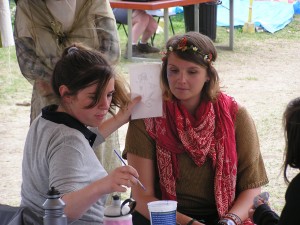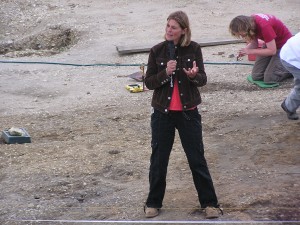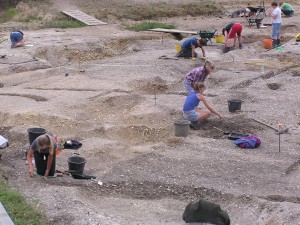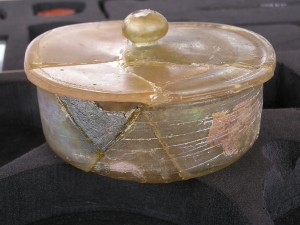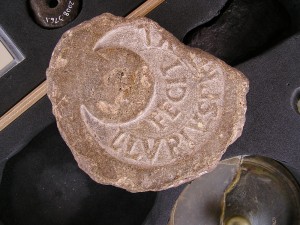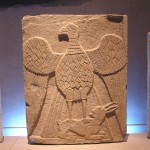
Michael I Keroularios was appointed the Ecumenical Patriarch of Constantinople in 1043, during the reign of the Emperor Constantine IX Monomachos. He is a great figure in the history of the Orthodox Church.
The Emperor Monomachos was keen to ally himself with the Papacy against the Normans, who had overrun his possessions in southern Italy. Unfortunately, the reformed church in the West was now insisting (unhistorically) on the effective primacy of the Pope of Rome, and his entitlement to enforce religious discipline and conformity over the whole of Christendom.
Among other differences, the Westerners fasted on the Sabbath, ate strangled meat and, above all, used unleavened bread, or ‘azymes’, in the Sacrament. These customs accorded with Judaical law, but not with the tradition of the early church, which considered itself to be under a new dispensation. The reformed Papacy was nevertheless determined to impose discipline and ‘correct’ practice throughout Christendom. Keroularios rightly suspected that the alliance would come at a heavy price, and was having none of it.
In 1054, he had an ill-tempered encounter with a distinguished papal delegation, which accused him of disobedience towards the Pope. Keroularios deliberately took no notice of them. As a result, the exasperated legates handed the disdainful Patriarch a bull of excommunication in the middle of a service in Hagia Sophia. Having stormed out of the cathedral, they theatrically shook the dust from their feet. Keroularios responded to this insult in kind, with the full support of the city, and the legates were obliged for their safety to hurry home.
Each side had been careful to direct its excommunications at a small number of individuals; and to represent the affair as marking the final schism between the two churches is a fallacy. It was, however, a landmark in the process of estrangement, when each side was fully and disturbingly exposed to the prejudices and claims of the other.
For the proud Byzantines, it was bad enough to be lectured by ‘heretics’ (the Westerners had tampered with the Nicene Creed by inserting the word ‘Filioque’). It was worse still when they were ‘barbarians’. The legates had addressed a wildly inaccurate tirade against Keroularios, who, in a lofty reply, described them as ‘men who had burst from the evening shadows of the West’ and ‘attacked like some wild boar’. Constantinople, he wrote, was ‘God’s protected city, whence the springs of orthodoxy, the pure waters of the true faith, will flow like streams from a mountain peak to water all corners of the Earth and quench the souls of all men with the divine teachings’. (See Will ed., Acta et Scripta de Controversiis Ecclesiae Graecae et Latinae; Steven Runciman, The Eastern Schism.)
Keroularios was not happy when, after the death of Monomachos in 1055, his sister-in-law, the porphyrogennete (‘purple-born’) Empress Theodora, sought to reign alone. Once friendly, she now ‘abominated the man, refusing even to meet him. There was a reason for this: the Patriarch was vexed because the Roman Empire was being governed by a woman. Characteristically he was filled with wrath at this state of affairs, and he spoke his mind freely.’ (Michael Psellos, Chronographia, VI, xviii, trans. Sewter, p.269.) He was no happier with her successor in 1056, the near-senile Michael VI – a mere puppet of the court eunuchs – and helped, by inciting a riot in the city, to engineer his deposition in 1057.
The habitually forthright Keroularios soon quarrelled with the new Emperor, Isaac I Komnenos. Having presented him with the throne, he felt entitled to share in his imperial power and, again, used ‘language that was somewhat bold’. He is said also to have sported a pair of purple buskins, an act of treason, as purple garments were traditionally a prerogative of the Emperor. However, he had met his match in Isaac, a tough general with a no-nonsense approach.
In November 1058, Isaac arrested the troublesome Keroularios and exiled him to Prokonnesos, thus ‘casting the Patriarch off as if he were a load off his shoulders’. (Psellos, Chronographia, VII, 65, trans. Sewter, p.315; Skylitzes, 809, p.644.) Michael Psellos, a trained lawyer as well as ‘Consul of the Philosophers’ in the University founded by Monomachos, was instructed to prosecute him. Psellos’s detailed Accusation sets out the charges both of heresy and treason. However, Keroularios died unexpectedly, before coming to trial. Psellos says that the usually dour Isaac ‘bewailed his loss loudly and mourned him sincerely’, and – guilty at having brought down so great a personage – immediately rehabilitated his family at court.
These included the Patriarch’s niece, Eudokia Makrembolitissa, second wife of the vestarches Constantine Doukas, a nobleman from Paphlagonia. Eudokia was the daughter, by the Patriarch’s sister, of Ioannes Makrembolites, and according to Psellos was ‘a woman of great spirit, and exceptional beauty’. Interestingly, Psellos describes himself as Eudokia’s ‘uncle’ and, elsewhere, as ‘spiritual brother’ to her father, who was presumably his first cousin. Psellos was thus related by marriage, if not by blood, to the Patriarch. (D.I. Polemis, The Doukai (London, 1968), pp.28-34; K. Barzos, Ή Γενεαλογια των Κομνηνων (Thessalonica, 1984), I, p.125; Jean-Claude Cheynet, Pouvoir et contestations à Byzance (Paris, 1996), p.275.)
In the autumn of 1059, a disheartened Isaac himself became ill. Psellos, a proficient doctor among his other skills, convinced him (wrongly) that he was dying. That November, Isaac was persuaded to abdicate in favour of their mutual friend and relative, the amiable Constantine Doukas. The new Emperor entrusted the helm of state to Psellos, his wife’s uncle, who claims that Constantine drank his every word ‘like nectar’. The first duty of his former accuser was to pronounce, in the imperial presence, a glowing funeral oration, somewhat overdue, in honour of the dead Patriarch. An unashamed pen-for-hire and political survivor, Psellos now made him out to be a saint.
It is ironic that after the death of the Emperor Doukas in 1067, his widow Eudokia, niece of the misogynistic Patriarch Keroularios, should herself have assumed sole power, even sidelining her ‘uncle’ Psellos, until practical considerations forced her, in January 1068, to marry again. Her new husband, Romanos Diogenes, was the emperor who was defeated and captured by the Turks at the Battle of Manzikert. Psellos loathed Diogenes and, on his release from captivity in 1072, had him savagely blinded, an act of calculated brutality that horrified contemporaries. It enabled Psellos to resume his controlling influence in the court as chief minister to Eudokia’s son, the feeble Michael VII.
Psellos claims in his funeral oration that the Keroularioi were descended from Herakles. They had been patricians at least since the late 10th century, when a Keroularios served as a general (Cheynet, p.52, n.2), yet the family name means ‘candle-maker’. Their earlier ancestors were surely guildsmen in Constantinople, practising their craft in the hallowed environs over which Michael himself later presided. The many churches of Constantinople were, of course, vast consumers of candles.
The Pselloi were also a noble family. Their name, meaning ‘stammerer’, is most inappropriate for their most famous member, who was so renowned as an orator and conversationalist. Psellos reveals the little that is known about his immediate family in an earlier funeral oration that he had composed for his young daughter, Styliane Psellaina. She was his only child after many years of marriage, possibly to a woman called Theodote. (In desperation they had already adopted another girl, Euphemia.) In the summer of 1054, whilst Keroularios was smarting over the insults of the Papacy, Constantinople was in the grip of a smallbox epidemic, mentioned by the chronicler Skylitzes. The 9-year-old Styliane succumbed to the disease and died after 31 days of suffering.
Psellos clearly adored her and was heart-broken. He likens her to ‘a young, soft, tiny bird’. He delighted in her love of learning, in pursuit of which she would voluntarily visit school, presumably to sit at the back while the boys had their lessons; and speaks of her natural talents for weaving and embroidery. Skilled doctor that he was, he describes her illness in clinical detail; also the washing, dressing and laying out of her dead body, reduced to ‘one single open wound’. His later oration to Keroularios seems cold by comparison. (Panagiotis A. Agapitos, ‘Public and Private Death in Psellos: Maria Skleraina and Styliane Psellaina’, Byzantinische Zeitschrift, 101, ii (2008), pp.555-607.) It is the ‘private’ death that brings out Psellos’s innate humanity, and yet, if one thinks of him at all, it is probably not as the victim of a personal tragedy.
What lines of descent can be traced from these families to the present day? Hundreds of thousands, even millions of living people in the West can prove Byzantine ancestry from the eleventh century, through families such as the Komnenoi. Far fewer people, however, are able to establish a link with Psellos and Keroularios.
The Emperor Doukas had by their niece, Eudokia Makrembolitissa, a daughter, Zoe porphyrogennete. She married Adrian Komnenos, brother of the Emperor Alexios I. Their granddaughter, Anna Komnene Doukaina, married Alexios Palaiologos, a member of the last reigning dynasty in Byzantium.
This couple’s great-granddaughter, Theodora Palaiologina, married her third cousin, Andronikos Palaiologos, who died in 1247. They were the parents of the Emperor Michael VII Palaiologos (1259-82), from whom an exclusive number of Western families are able to trace their descent. I myself have a double descent from Michael.
In 1355, Michael’s great-great-granddaughter Maria was given in marriage by her brother, the Emperor John V, to Francesco Gattilusio, a Genoese buccaneer in his service, whom he made lord of Mytilene or the island of Lesbos. (D.M. Nicol, The Last Centuries of Byzantium (Cambridge, 1972), p.256.) Their granddaughter, Catarina Gattilusio, married Pietro di Grimaldi, Baron of Bueil. Thence the line is traced directly, through thirteen generations, to my French great-grandmother. It is thrilling to think that I am flesh and blood with the likes of Psellos and Keroularios, and, indeed, one of their nearest living relatives.


